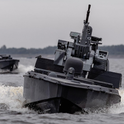A veteran of the great patriotic war, whom I have known for the past five years, turned up at my dacha outside Moscow at the end of May and described how Boris Yeltsin has been fighting for re-election.
My friend had been a fighter pilot on the Belarusian front when Hitler launched Operation Barbarossa. He survived to fly secret missions from Chinese airfields against the Americans during the Korean war-another hot time for Soviet pilots. I asked how life was treating him, and awaited the usual litany: Gorbachev had thrown away Europe for a train-load of chicken legs, Yeltsin had sold Russia to criminals, and here he was, a decorated war veteran, trying to survive on a paltry pension that was paid late.
Instead, he gave a smile which revealed gold-capped molars I had not seen before. No, life was as good as it could be for an old man, he said. His veteran's pension had been increased and now covered his needs. He still had his health-hadn't he just walked from the railway station? Moreover, he had received on Victory Day, 9th May, a letter of congratulations not only from the defence minister but one from Boris Nikolaevich himself, on Kremlin notepaper. That sealed it. He was voting for Yeltsin on 16th June.
The penny dropped. So many of those angry people whose support for the communists dominates western television screens remember the war. They are trying in their anger to remind people of what it meant. In his bid to do away with communism, Boris Yeltsin trod on those memories and desecrated their symbol: the red flag. By allowing it to fly beside the Tsarist tricolour on Victory Day, and by sending out those letters, Yeltsin was saying sorry.
In his campaign, Yeltsin has gone out of his way to win over Gennady Zyuganov's communist supporters, to raid his heartlands of the elderly, the veterans, the village peasants. As well as restoring pensions and putting the Kremlin auto-pen to work on letters to war heroes, he has made a powerful appeal to village opinion by coming out as a champion of the Orthodox church. The pay-off came in an endorsement from Patriarch Alexei II, who urged the flock to vote wisely in the elections. This Orthodox version of a Papal Bull did not mention Yeltsin by name; it didn't need to. No one would imagine that by asking them to vote wisely, Patriarch Alexei thought they should vote for Zyuganov.
The presidential elections have been treated in the west as a competition between two candidates: Yeltsin and Zyuganov. But it is more a competition between two electorates. The shape of these electorates was sketched in last December's elections to the state duma-a kind of giant opinion poll in which the democratic parties and the centrists won about 20 per cent and the communists almost 60 per cent. This was correctly portrayed as a significant shift in support away from reform and towards the defenders of collective ownership. What was not justified, however, was the conclusion that Russians had taken a long, cold look at the market economy and decided to reject it.
Before examining the December election results, I wrote down the centres where private ownership has, in my own observation, been seriously tried: Moscow, St Petersburg, Yaroslavl, Nizhni-Novgorod, Yekaterinburg, Khabarovsk and Vladivostok. All showed stronger than average votes for the democratic parties-an indicator of greater than average support for reform. Looked at the other way, all but Primorskiy, centred on Vladivostok, showed a lower than average vote for the communists. So far, so good.
What this calculation based on private ownership failed to predict was the pattern of other places in Russia proper, where the democrats (while still out-voted by the communists) did relatively well. These 12 regions are either on or adjoin the old trade routes: the White Sea, the Volga river, the trans-Siberian railway, the Baltic Sea, the Paci- fic Ocean, the Sea of Okhotsk, the Barents Sea, the Kama river, the Don river, the Sea of Japan and the Ob river.
On the other side of the ledger the pattern is equally marked. The big votes for the communists were cast in the districts southeast from Smolensk and Bryansk, near the Belarusian border, through Orel and Kursk to Lipetsk, Tambov and Penza-the "red belt."
What are the elements defining the red belt? First, it endured the Hitler invasion and suffered some of the fiercest fighting of the great patriotic war. The footprints of the Wehrmacht occupation and of the red belt on the map of European Russia are a close match. Second, it is the heartland of collective agriculture in Russia. Third, it is mostly well away from the trade routes. Yeltsin was never likely to win a majority of votes there-but then he never had to. Nationally, the election was his if he could win a slice of their fat communist majorities. That is why he set the red flag flying over the Kremlin again on Victory Day. It takes a communist to catch a communist.
Red letter day
Where reform has been tried in Russia, democrats thrive. Communist strength, on the other hand, follows the path of Hitler's invasion
July 19, 1996











